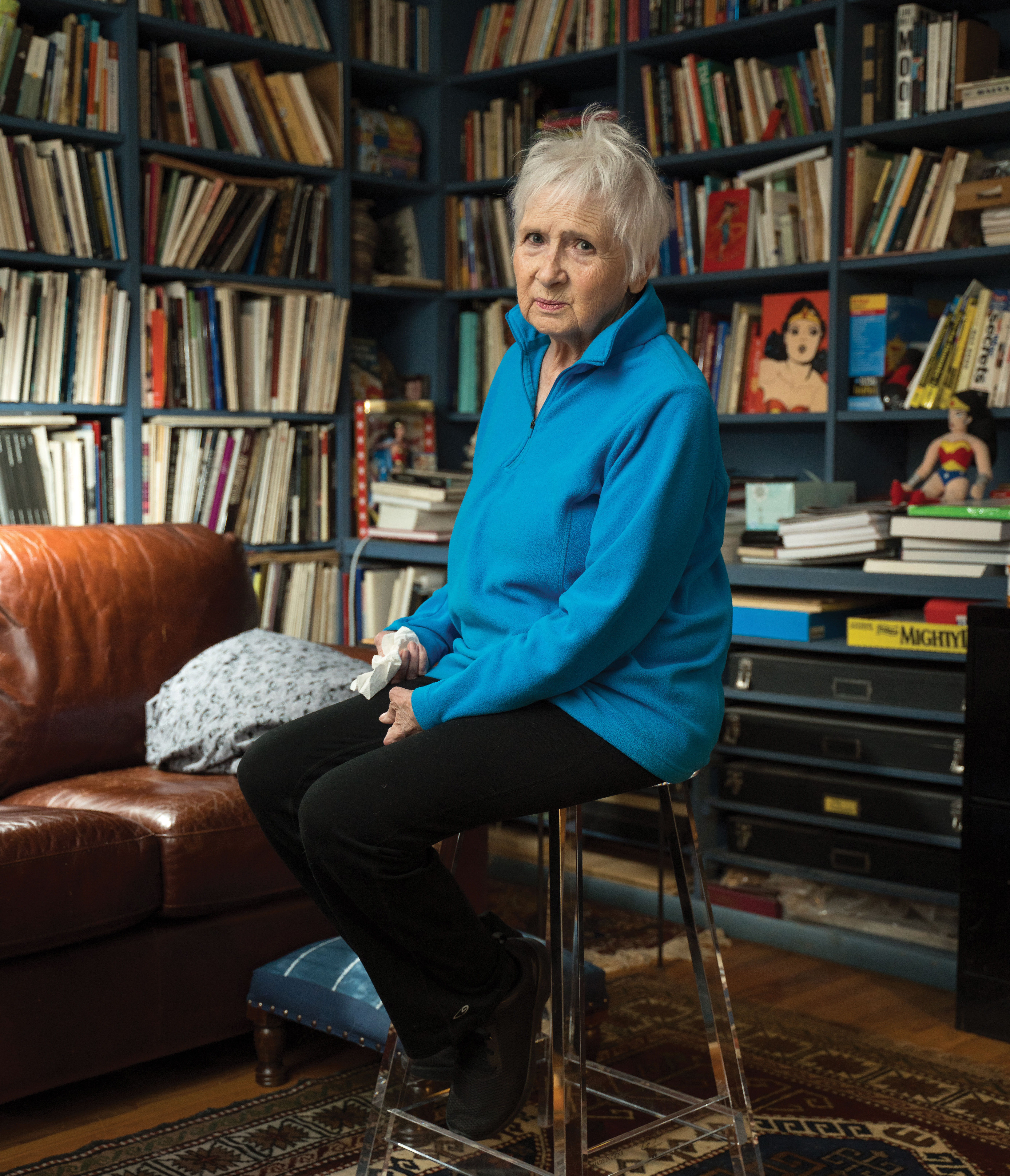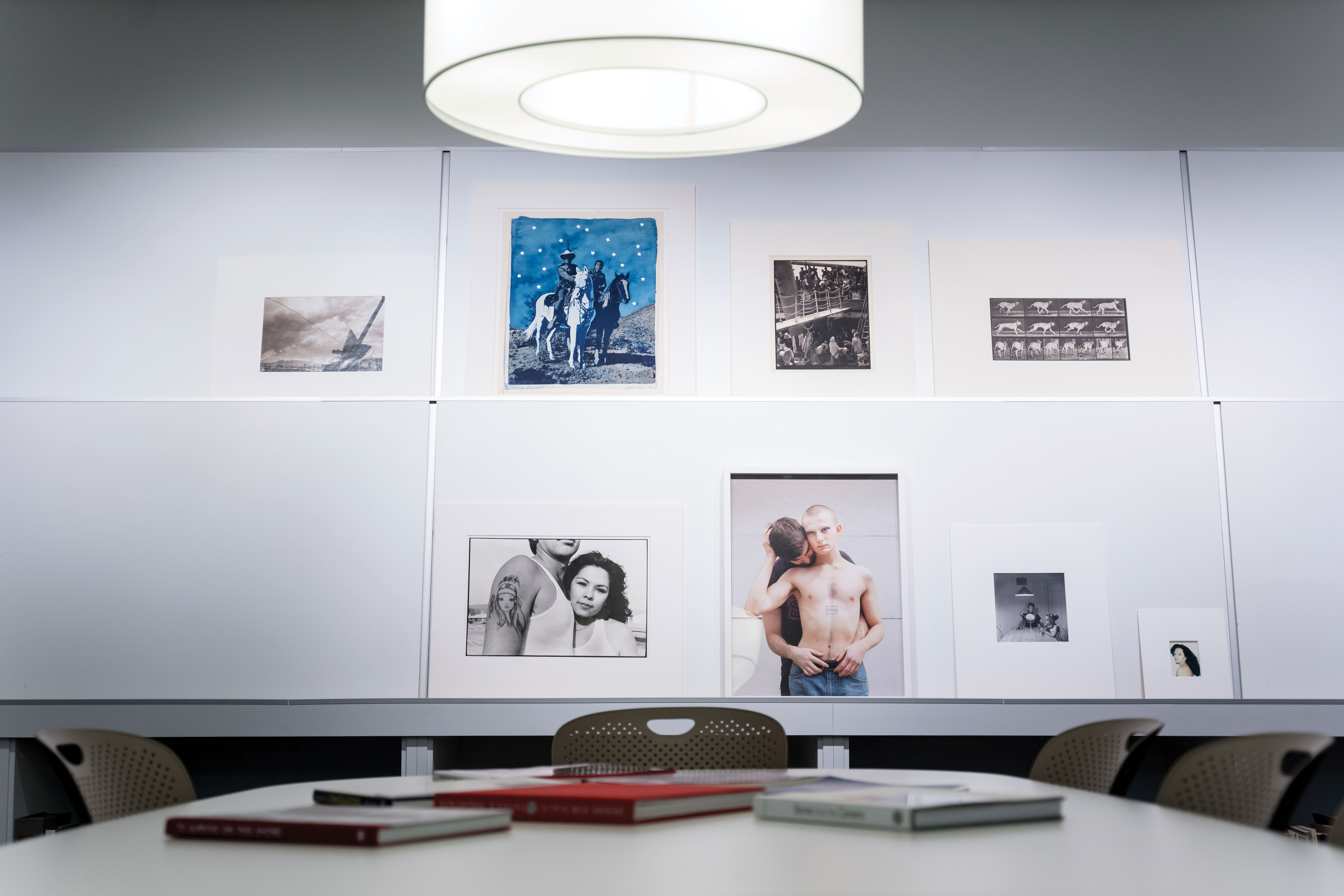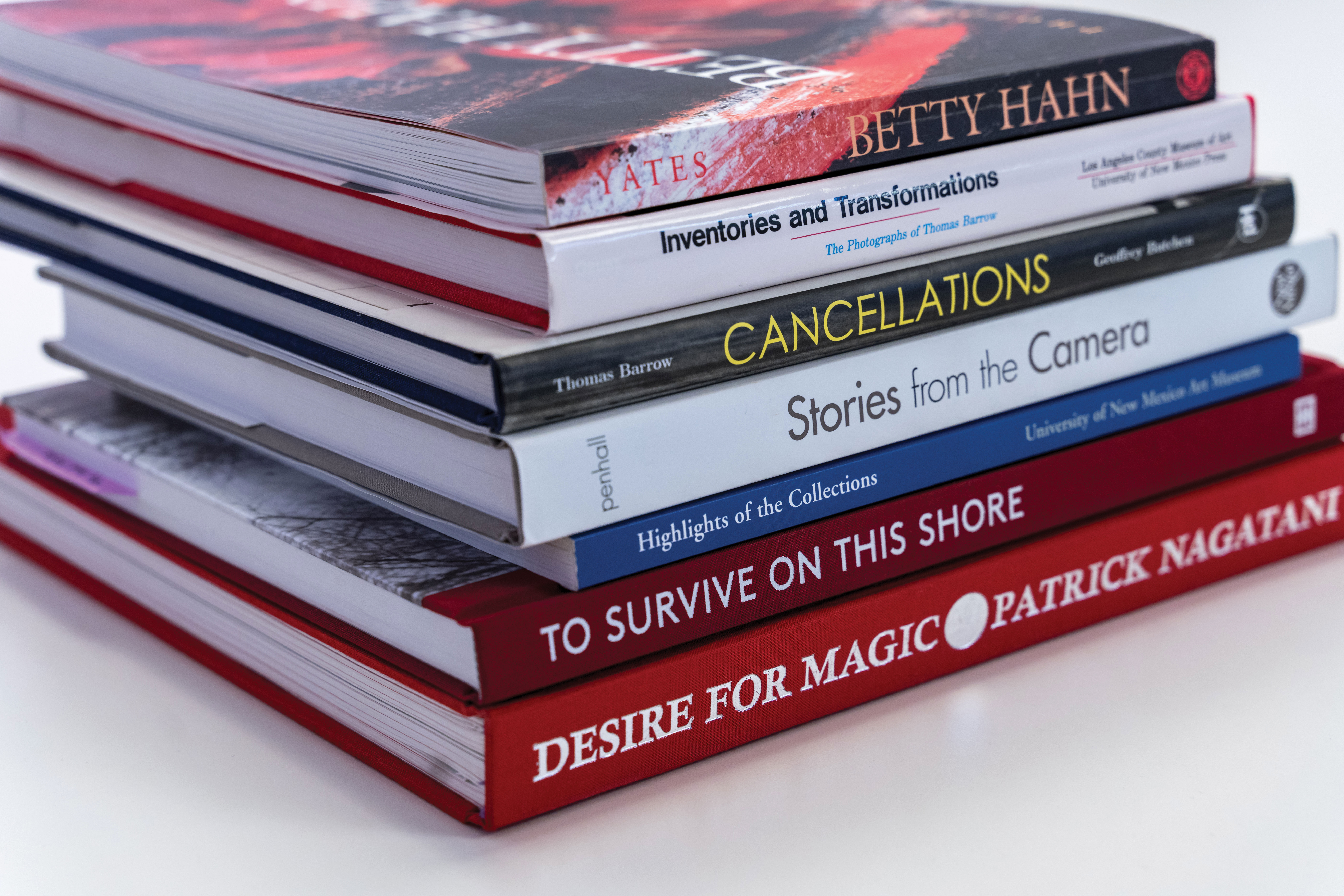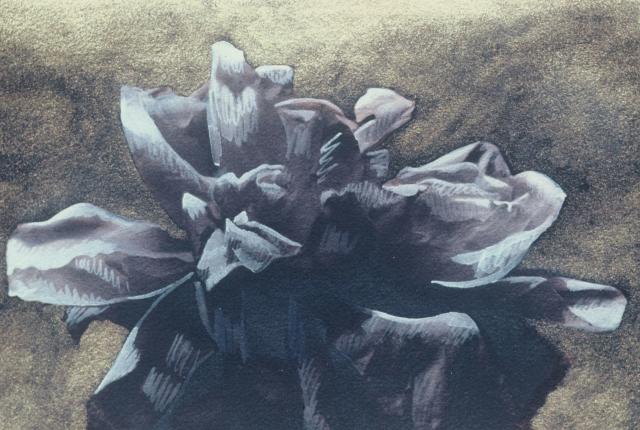Above: Betty Hahn's "Dark Peony on Gold." Photograph by Betty Hahn.
WILL WILSON HAS ALREADY BEGUN experimenting with photography when he first saw Joel-Peter Witkin’s simply titled show Forty Photographs at the San Francisco Museum of Modern Art. By then the teen had moved too many times to count between the Bay Area and the Navajo Nation—but he still remembers being 15 and looking at the pictures.
Titles were cryptic and disturbing—almost as chilling as the black-and-white photos themselves. Sitters’ faces were often masked, their bodies nude and posed among macabre props like shadowy figures from a nightmare. When I look at them now, they still haven’t lost their capacity to unsettle.
Curated by Van Deren Coke, Forty Photographs was on view from December 1985 to February 1986. While American critics were ambivalent about what they saw, the pictures nonetheless awakened something in Wilson. “I was just totally blown away,” he says. “Afterward, I read Witkin’s bio and it said he went to UNM. I decided then and there that I would go to UNM, too. And I eventually did.”
Witkin received his MFA in photography at UNM the same year the exhibition hit the Bay Area. He’d arrived in New Mexico in the mid-seventies, at the cusp of the “photo boom,” a coming of age for fine art photography in cities like Rochester, Los Angeles, New York, Chicago, and Albuquerque.
Read more: Spinning complex histories of indigeneity into a creative practice.
It was no coincidence that Coke, director of photography at SFMOMA, had curated the show, for he had also founded UNM’s graduate program in photography, where Witkin was a student. From 1962 until 1979, when he left for San Francisco, Coke mentored students, hired faculty, and acquired a robust collection of photography for the University Art Museum, building the infrastructure for a program that, to Wilson, “came to fruition in ways totally unforeseen.”
In response to a previous generation of purists, UNM emphasized creative expression and innovation. Photographers staged uncanny tableaux, devised visual illusions in the darkroom, and scratched onto the very surface of negatives. They combined painterly processes with photographic ones and poked fun at pop culture’s ideas of the Wild West, producing images of tract houses multiplying to the horizon, or deadpan views of city streets, each a rejoinder to the romantic, unpeopled vistas that had once dominated Western photography.
Today, the graduate program draws national and even international raves. Many of its graduates have carried on the tradition of teaching and the desire to make photographs that are self-aware, critical, and uncompromising.
Witkin was only one of many students who would send ripples through the art world.
 Above: Betty Hahn in her study. Photograph by Steven St. John.
Above: Betty Hahn in her study. Photograph by Steven St. John.
There’s also Thomas Joshua Cooper, who was recently profiled in The New Yorker for his reckless sojourns to the ends of the earth to capture places like the polar ice shelf with a 19th-century camera. Others include Nicholas Nixon, Joe Deal, Miguel Gandert, Meridel Rubenstein, First Nations photographer Rosalie Favell, and tintype virtuoso Will Wilson.
“YOU'LL START TO SEE THIS amazing network—little dots on the map and little lines connecting them,” Betty Hahn says after leading me to a brown leather couch in her study, a room that is dim in the late-afternoon light. She sits across from me like an old friend might, her snow-white hair framed by shelves and shelves of books and a couple of Wonder Woman dolls that I intimate must symbolize her own ascent into the male-dominated world of creative photography. And then there’s artwork—her own, as well as Bea Nettles’s, Robert Rauschenberg’s, and Van Deren Coke’s, to name only a few—covering every other free surface of her Albuquerque home.
“Think of pushpins with string attached,” she adds, evoking a network of photographers who crossed paths at UNM nearly 50 years ago and ultimately put it on the map.
Until the late fifties and early sixties, photography was perceived as less a creative process than a means for reproducing what the eye could see. It was documentary—journalistic, even—but rarely considered art. A handful of photographers and educators, including Coke, hoped to change that perception. They challenged the chemical and visual possibilities of the medium and began introducing it into universities as a legitimate academic discipline. When Clinton Adams, dean of the College of Fine Arts at UNM, hired Coke in 1962 as director of the University Art Museum (formerly known as the University Art Gallery), both men tackled that charge in earnest.
Read more: An Albuquerque photographer pictures the beauty of her community.
With Adams’s support, Coke founded an MA program in photography, which required two years of study, and a more rigorous and longer MFA program, which required students to write a book-length dissertation in addition to making their portfolio.
“Van wanted the best program there was, so he started picking off people” from other institutions, Hahn says, naming photographer Rod Lazorik, who came to UNM first in 1966.
Then came Thomas Barrow and renowned photo historian Beaumont Newhall, both of whom Coke recruited in the early seventies from the prestigious George Eastman Museum, in Rochester, New York. Anne Noggle, a graduate of UNM’s art program and a former Air Force pilot, taught portraiture. Hahn, who was a professor of photography at the Rochester Institute of Technology, was Coke’s last hire, in 1975.
“Van Deren Coke was famous for saying, ‘I will never hire a woman because they’ll just get married, have kids, then quit,”’ she says, with only the slightest smile belying the irony that she never did quit. “But Van knew what I could do and thought the program could use my name along the way.” Hahn stayed at UNM until her retirement in 1997.
By that point, Hahn had begun printing images on fabric with the gum bichromate process, having taught herself from 19th-century French manuals. She then hand-stitched the images’ contours—the edges of a head of lettuce, a person’s cheekbone, a garden of flowers, stripes on a shirt or a road—with brightly colored thread, her own tactile and diminutive atlases of places, people, and things.
The work, she tells me while opening a flat file filled with these and other luscious objects from throughout her career, was always autobiographical. “Writers make autobiographies and keep journals. I do this.”
 Above: Photography's past and present at UNM Art Museum's print study room. Photograph by Steven St. John.
Above: Photography's past and present at UNM Art Museum's print study room. Photograph by Steven St. John.
In 1986, Patrick Nagatani, a former Hollywood set designer, joined the faculty. He brought to UNM his own inspired way of orchestrating detailed picture worlds into nuclear landscapes, evoking a sense of irradiation through extreme chemical coloring.
Nagatani, who died in 2017, was known to tell his students that the magic of photography could be found in “living in the story.” It was a method Wilson recalls as the “directorial mode”—staging a visual narrative that looked close enough to reality that viewers might suspend their disbelief. Wilson, who attended UNM some 10 years after seeing Witkin’s show, eventually absorbed that method into his own practice. His series Autoimmune Response pictures a Diné man navigating a post-apocalyptic landscape.
While the program’s structure has changed in the last two decades, faculty members continue the tradition of radical open-mindedness: Know the rules of photography in order to break them. Students who are admitted (usually around five per year) must come with a solid sense of self and confidence in their practice. “And they have to study photography’s history,” Hahn says, “not to repeat it.”
To Jim Stone, distinguished professor of photography at UNM, Albuquerque “is an odd experiment for people, flyover country.” And yet, like others before him, he’s made it his home and, for more than two decades, taught not photography but “how to think about photography.”
“Have you heard of the Alexey Brodovitch quote?” he asks me. “I’m not a teacher, I’m a can opener.”
“The students who are exceptional want to go to New York City or Los Angeles. We get a certain kind of student here—they have to spend time working and not trying to get famous,” Stone tells me. “They’re here to figure out how to make the world care.”
PHOTOGRAPHER JESS DUGAN'S EXHIBITION To Survive on This Shore: Photographs and Interviews with Transgender and Non-Conforming Older Adults is in its last weeks at the University Art Museum’s Raymond Jonson Gallery on the day I visit. Upstairs, Zach and Oskar, one of Dugan’s photos purchased for the permanent collection, shows two men embracing. One looks forward, unflinching yet vulnerable.
Dugan’s photo is surrounded by other work culled from the permanent collection, including that of Hahn, Miguel Gandert, Eadweard Muybridge, Thomas Barrow, Carrie Mae Weems, and Andy Warhol, whose Polaroid of Diana Ross is washed out but still glamourous.
Standing before them, I recall Nagatani’s words: “Photography is a representation of a moment.” Together, all these moments add up to a curious compression of time—and examples of photography’s past and present. The few pictures before me count as only a fraction of the University Art Museum’s vast collection. There are some 12,500 photographs in total, ranging from 1840 to the present, many collected during the sixties and seventies under Coke and Adams. Newhall’s 1984 MacArthur “Genius Grant” funded some 100 more. Others were gifted to or acquired by the museum in the following years.
 Above: Photo books from UNM's best. Photograph by Steven St. John.
Above: Photo books from UNM's best. Photograph by Steven St. John.
Dugan’s work is the most recent acquisition, four photographs made possible by a fund for diversity and equity.
The collection, which is encyclopedic in scope, was meant to “expose students and faculty to original works of art,” a mission that holds true today, says Mary Statzer, curator of prints and photographs for the museum.
She walks me to a daguerreotype, a ghostly image that’s framed in rich red velvet. Hahn’s cyanotype from the Lone Ranger series also catches my eye, its azure sky bedecked with dime-store silver stars, the kind my teacher would’ve put on a paper in the third grade. I’ve never seen them look so beautiful.
In the study room, photography is all right there, presented in proper scale without mediation, a visual experience, but somehow also more. When I see the photos up close like this, all my senses are activated.
In the years to come, Statzer will continue to acquire works that are “as inclusive and relevant as possible,” adding voices that aren’t always represented in most museums, including women, LGBTQ people, and people of color. She, along with current faculty and students, believe this approach will, through photography, yield visions of worlds that otherwise go unrecognized in the mainstream.
“I spend a lot of time trying to help people understand creating of any history can only be of its time,” Statzer says. “It’s important to critique and move beyond those biases. We can provide that nuance,” not only by interpreting photography in the museum’s many exhibitions but also by collecting new examples of photography far into the future.
“We wanted to see UNM as a place of learning, of adventures,” says Hahn. “I always thought photography was a great adventure.”

ON EXHIBIT
Word Play opens February 8 at the New Mexico Museum of Art, in Santa Fe. The exhibit will include prints by the famed Ed Ruscha and Bruce Nauman and work from what Kate Ware, curator of photography, calls “the UNM bunch,” including Thomas Barrow, Van Deren Coke, Betty Hahn, and Meridel Rubenstein, in addition to prints made at the Tamarind Institute, in Albuquerque. It features a range of themes, “from the playful to the cryptic to the political,” Ware says.


